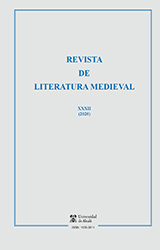Sobre el destino, la maldición y la obediencia en el ciclo de los Volsungos
La representación de la estructura de parentesco como condena
DOI:
https://doi.org/10.37536/RLM.2020.32.0.73666Palabras clave:
Vǫlsunga saga, Reinterpretación, Obligaciones de parentesco, Destino, MaldiciónResumen
El objetivo del presente artículo es poner en tensión la Saga de los Volsungos y las fuentes que utilizó su autor para desarrollar esta obra. Nos centraremos especialmente en el Reginsmál y en las diferencias que presentan ambos escritos en la representación de la familia de Hreiðmarr. Se demostrará que las variaciones entre ambas fuentes sirven para enfatizar los dos patrones fundamentales de la saga: por un lado, acentúa la sobreestimación de las relaciones de parentesco y muestra las obligaciones que se desprenden de su estructura como deberes inexorables. Por otro lado, resalta el carácter nocivo de la maldición del tesoro de Andvari sobre la estructura familiar. Posteriormente argumentaremos que estas dos dinámicas no actúan de forma aislada, sino que se prestan a la comparación. Veremos que la estructura de parentesco se equipara al destino y a la maldición en tanto en cuanto sus obligaciones resultan igual de negativas e inevitables que el maleficio del oro de Andvari. Finalmente, se pondrá en relación el significado de la obra con su contexto de producción. Argumentaremos que la función de Vǫlsunga saga está enfocada a castigar un determinado orden de las cosas que amenaza las buenas prácticas y las ideologías del sistema que se pretende legitimar.
Descargas
Métricas alternativas
Descargas
Publicado
Cómo citar
Número
Sección
Licencia
Las opiniones y hechos consignados en cada artículo son de exclusiva responsabilidad de sus autores. La Universidad de Alcalá no se hace responsable, en ningún caso, de la credibilidad y autenticidad de los trabajos.
Los autores conservan los derechos sobre sus trabajos, aunque ceden de forma no exclusiva los derechos de explotación (reproducción, edición, distribución, comunicación pública y exhibición) a la revista. Los autores son, por lo tanto, libres de hacer acuerdos contractuales adicionales independientes para la distribución no exclusiva de la versión de la obra publicada en la revista (por ejemplo, alojarlo en un repositorio institucional o publicarlo en un libro), siempre que medie un reconocimiento de su publicación inicial en esta revista.
Los trabajos se publican bajo los términos estipulados en la Licencia de Atribución-NoComercial-CompartirIgual 4.0 Internacional Creative Commons (CC BY-NC-SA 4.0) que permite a terceros compartir la obra bajo las siguientes condiciones:
Atribución — Usted debe dar crédito de manera adecuada, brindar un enlace a la licencia, e indicar si se han realizado cambios. Puede hacerlo en cualquier forma razonable, pero no de forma tal que sugiera que usted o su uso tienen el apoyo de la licenciante.
NoComercial — Usted no puede hacer uso del material con propósitos comerciales.
CompartirIgual — Si remezcla, transforma o crea a partir del material, debe distribuir su contribución bajo la misma licencia del original.









